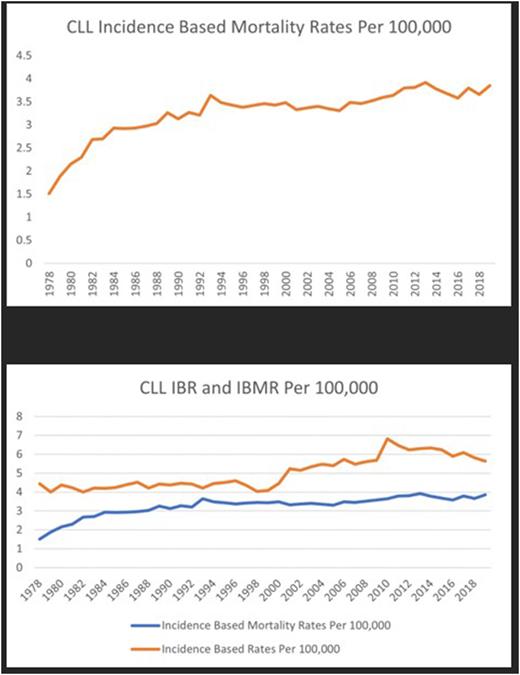Abstract
Background: Chronic lymphocytic leukemia (CLL) is the most common leukemia among adults, with more than 90% of newly diagnosed cases occurring in patients more than 64 years of age. It is to be noted that multiple studies reported improved survival over the past 4 decades which is attributed to advancement in treatment and understanding of the disease. However, to better examine the burden of CLL in the United States (US) we investigated the incidence and incidence-based mortality rates in the US over the past 4 decades using the Surveillance, Epidemiology, and End Results (SEER) database.
Methods: SEER-8 registry, 8.3% of the US population, was used to study CLL/SLL cases from 1978-2019. Incidence-based (IBR) and incidence-based mortality (IBMR) rates were calculated by sex, age, and ethnicity/race. Patients were divided into four categories according to age of diagnosis, wherein <55 (young-onset CLL), 55-64, 65-74 and >75 years of age. Annual percent change was then calculated using joinpoint regression software. The best model with the least number of joinpoints was then selected.
Results: Over the study period, CLL IBR increased by 0.75% (p=0.202). The overall IBR steadily increased from 1978 until 2013 before declining at a rate of -2.05%/year (p=0.031). Males’ IBR plateaued until 1998 followed by an increase of 2.80%/year (p<0.001) until 2011 only to then decline by -1.72%/year (p=0.028). Similarly, females’ IBR had insignificant fluctuations from 1978-2002 followed by an increase of 2.44%/year (p<0.001) until 2011 and an insignificant decline from 2011-2019 (APC=-1.07%/year, p=0.222). Among patients with young-onset CLL, IBR increased by 0.57%/year (p=0.034) up to 2008 and by 11.89%/year (p=0.521) from 2008-2011, followed by a decline of -1.39%/year (p=0.465). Likewise, patients >75 years of age's IBR declined by 0.52%/year (p=0.028) till 1998, increased by 4.01%/year (p<0.001) to 2010, and then declined by 2.02%/year (p=0.011). After years of increasing rates among Whites', IBR declined among Whites beginning in 2013 (APC=-2.12%/year; p=0.037). In contrast, Blacks’ rates increased by 0.96%/year (p<0.001) throughout the study period. (Figure)
Over the study period, CLL IBMR was 2.10%/year (p<0.001). The overall CLL IBMR steadily increased from 1978 till 2012 and stabilized at -0.38%/year (p=0.457) until 2019. Males’ IBMR increased by 26.61%/year (p<0.001) during 1978-1980, then increased at a slower rate of 2.97%/year (p<0.001) and 0.46%/year (p<0.001) between 1980-1989 and 1989-2019, respectively. Similarly, females’ rates increased by 11.91%/year (p<0.001) between 1978-1984, and by 0.52%/year (p<0.001) between 1984-2019. Young-onset CLL rates increased by 46.69%/year (p=0.236) during 1978-1980, then declined by -1.85%/year (p<0.001) from 1980 to 2019. In contrast, >75 years old's IBMR increased by 14.00%/year (p<0.001) between 1978-1982 followed by a steady increase of 1.30%/year between 1982-2019. Whites’ IBMR increased from 1978 till 2012, then plateaued at a rate of -0.10%/year (p=0.857) until 2019. Blacks’ IBMR increased by 7.65%/year (p<0.001) between 1978-1991 followed by an insignificant decline of -4.87%/year (p=0.063) from 1991-2000 and an increase of 1.40%/year (p=0.056) between 2000-2019. (Figure)
Conclusion: Our findings showed a decline in CLL incidences since 2013, with plateauing of mortality rates since 2012 which is in line with recent advances in the management of CLL. Additionally, our study demonstrated improved mortality rates among the black population and those <75 years of age. Further studies will be needed to better characterize the effect of newer targeted therapies on IBMRs.
Disclosures
No relevant conflicts of interest to declare.
Author notes
Asterisk with author names denotes non-ASH members.


